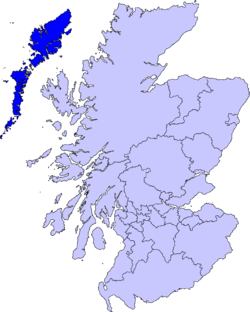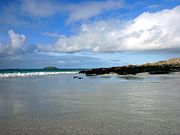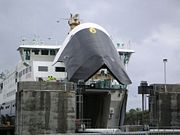
Outer Hebrides
Background to the schools Wikipedia
SOS believes education gives a better chance in life to children in the developing world too. Click here for more information on SOS Children.
| Na h-Eileanan Siar (The Western Isles) |
|
|---|---|
| Location | |
 |
|
| Geography | |
| Area | Ranked 7th |
| - Total | 3,071 km² |
| Admin HQ | Stornoway (Steòrnabhagh) |
| ISO 3166-2 | GB-ELS |
| ONS code | 00RJ |
| Demographics | |
| Population | Ranked 30th |
| - Total (2010 est.) | 26,200 |
| - Density | 9 / km² |
| Politics | |
| Comhairle nan Eilean Siar http://www.cne-siar.gov.uk/ |
|
| Control | |
| Independent | |
| MPs |
|
| MSPs |
|
The Outer Hebrides, ( officially known for local government purposes by the Gaelic name, Na h-Eileanan Siar) comprise an island chain off the west coast of Scotland. The local government area is one of the 32 unitary council areas of Scotland.
The islands form part of the Hebrides, separated from the Scottish mainland and from the Inner Hebrides by the stormy waters of the Minch, the Little Minch and the Sea of the Hebrides. Formerly the dominant language of the Islands, Scottish Gaelic remains widely spoken even though it has now been largely supplanted by English in some parts.
The name for the UK Parliament constituency covering this area is Na h-Eileanan an Iar, whilst the Scottish Parliament constituency for the area continues to be officially known as Western Isles although it is almost always written as Western Isles (Eilean Siar). The islands were known as Suðreyjar ("Southern Islands"; cf. Suðrland) under Norwegian rule for about 200 years until sovereignty was transferred to Scotland in the Treaty of Perth in 1266, which followed the Battle of Largs three years earlier. Colloquially, they are sometimes referred to collectively as An t-Eilean Fada or "The Long Island"; Na h-Eileanan a-Muigh (the Outer Isles) is also heard occasionally in Scottish Gaelic.
Islands
The main islands form an archipelago. With their smaller surrounding islands these are sometimes known poetically as the Long Isle. The major islands include Lewis and Harris, North Uist, Benbecula, South Uist, and Barra. Much of the western coastline of the islands is machair, a fertile low-lying dune pastureland.
Populated islands
| Island | Population (2001 census) |
| Lewis and Harris | 19,918 |
| South Uist | 1,818 |
| North Uist | 1,271 |
| Benbecula | 1,219 |
| Barra | 1,078 |
| Scalpay | 322 |
| Great Bernera | 233 |
| Grimsay | 201 |
| Berneray, North Uist | 136 |
| Eriskay | 133 |
| Vatersay | 94 |
| Baleshare | 49 |
| Grimsay, South East Benbecula | 19 |
| Flodaigh | 11 |
| TOTAL (2001) | 26,502 |
Unpopulated islands
The unpopulated islands include:
- Barra Isles, Boreray
- Calvay, Campay
- Eilean Chaluim Chille, Eilean Iubhard, Eilean Kearstay, Eileanan Iasgaich, Ensay
- Fiaray, Floday, Flodday, Floddaybeg, Flodaigh Mòr, Fuday, Fuiay
- Gighay, Gilsay, Groay
- Hellisay, Hermetray
- Killegray, Kirkibost
- Lingay, Little Bernera
- Mealasta Island, Mingulay
- Opsay, Oronsay, Orosay
- Pabbay near Harris, Pabbay Mòr
- Ronay
- Seaforth Island, Scaravay, Scarp, Scotasay, Shiant Islands, Shillay, Soay Beag, Soay Mòr, Stockinish Island, Stromay, Stuley, Sursay
- Tahay, Taransay
- Vacsay, Vallay, Vuia Beag, Vuia Mòr
- Wiay
Small islands and island groups pepper the North Atlantic surrounding the main island group:
To the west lie the Monach Islands, Flannan Isles, St Kilda, and Rockall, in increasing order of distance. The status of Rockall as part of the United Kingdom remains a matter of international dispute. About halfway between St Kilda and Rockall is Anton Dohrn Seamount, a large submerged volcano.
To the north lie North Rona and Sula Sgeir, two small and remote islands. Not often included as part of the Outer Hebrides, they nevertheless come under the administration of the Western Isles district.
Gaelic in the Western Isles
The Western Isles have historically been a very strong Gaelic speaking area. Both in the 1901 and 1921 census, all parishes were reported to be over 75% Gaelic speaking, including areas of high population density such as Stornoway. By 1971 most areas still had more than 75% of speakers with the exception of Stornoway, Benbecula and South Uist, all at 50-74%.
It remains a relatively strong Gaelic speaking area in spite of a continued decline. In the 2001 census, each Hebridean island overall had over 50% speakers: Lewis 56%, Harris 69%, North Uist 67%, Benbecula 56%, South Uist 71% and Barra 68%. With 59.6% of Gaelic speakers or a total of 15,842 speakers, this made the Western Isles the most strongly coherent Gaelic speaking area in the world.
The areas with the highest density are:
- Scalpay, Newtonferry and Kildonan (all over 80%)
- Daliburgh, Linshader, Eriskay, Brue, Boisdale, West Harris, Ardveenish, Soval, Ness, Scaliscro and Bragar (all over 75%)
Most other areas have between 60-74%.
The lowest density of speakers are found in Stornoway 44%, Braigh 41%, Melbost 41%, and Balivanich 37%.
The Hebrides under Norse control
The Outer and Inner Hebrides came under Norse control and settlement before the 9th century AD. The Norse control of the Hebrides was formalized in 1098 when Edgar of Scotland formally signed the islands over to Magnus III of Norway. The Scottish acceptance of Magnus III as King of the Isles came after the Norwegian king had conquered the Orkney Islands, the Hebrides and the Isle of Man in a swift campaign earlier the same year, directed against the local Norwegian leaders of the various islands. By capturing the islands Magnus III subdued the Norsemen, who had seized the islands centuries earlier, and imposed a more direct royal control.
Norse control of both the Inner and Outer Hebrides would see almost constant warfare until being ultimately resolved by the partitioning of the Western Isles in 1156. The Outer Hebrides would remain under the Kingdom of Mann and the Isles while the Inner Hebrides broke out under Somerled, the Norse-Celtic kinsman of both Lulach and the Manx royal house.
After his victory of 1156, Somerled went on two years later to seize control over the Isle of Man itself, and become the last King of Mann and the Isles to rule over all the islands the kingdom had once included. After Somerled's death in 1164 the rulers of Mann would only be in control of the Outer Hebrides.
As a result of the 1266 Treaty of Perth the Outer Hebrides, along with the Isle of Man, were yielded to the Kingdom of Scotland.
Local government
The Western Isles have been a unitary council area since 1975. In most of the rest of Scotland, however, similar unitary councils were not established until 1996. Since then the islands have formed one of the 32 unitary council areas which now cover the whole of Scotland. The Western Isles council is officially known by its Gaelic name, Comhairle nan Eilean Siar, and known locally simply as 'the Comhairle' or 'a' Chomhairle', having changed its name under the Local Government (Gaelic Names) (Scotland) Act 1997. The council has its base in Stornoway on Lewis.
Lewis is in the north of the island group and forms part of the county of Ross-shire. The rest of the group, including Harris, is part of Inverness-shire. Between 1890 and 1975 administration was split, by the Lewis-Harris boundary, between the county councils of Ross and Cromarty (which covered Ross-shire and Cromartyshire) and Inverness-shire.
The Western Isles is a member of the International Island Games Association.
Religion
The Christian religion has deep roots in the Western Isles, but owing mainly to the different allegiances of the clans in the past, the people in the northern islands (Lewis, Harris, North Uist) have historically been predominantly Protestant ( Presbyterian), and those of the southern islands (Benbecula, South Uist, Barra) predominantly Roman Catholic. There are also small Episcopalian congregations in Lewis and Harris, though many of their members originate outside the islands.
The northern parts of the Western Isles (particularly Lewis and Harris) have been described as the last bastion of fundamentalist Calvinism in Britain with large numbers of inhabitants belonging to the Free Church of Scotland or the still more conservative Free Presbyterian Church of Scotland. Services in the Free Church, the Free Presbyterian Church and some congregations of the Church of Scotland do not use instrumental music or any songs other than the metrical Psalms. In 2006 controversy arose over the decision of a local ferry company to sail to Harris on the Sabbath .
It has also generally been considered unacceptable for people to appear in church improperly dressed, although this is slowly changing. Violations of this nature might include the failure by women to wear a hat, or trousers being worn instead of a skirt, or the wearing by worshippers of either sex of informal clothing such as jeans. The local council refused in December 2005 to conduct formal ceremonies for same-sex couples wishing to register under the Civil Partnerships Act 2004, though would accept all registrations of couples as required by law.
South of Harris, Sunday observance is less strict.
Ferries
Scheduled Ferry services between the Outer Hebrides and the Scottish Mainland and Inner Hebrides operate on the following routes:
- Oban to Castlebay on Barra and Lochboisdale on South Uist
- Uig on Skye to Tarbert on Harris
- Uig on Skye to Lochmaddy on North Uist
- Ullapool to Stornoway on Lewis
- Tiree to Castlebay, Barra (summer only)
Other ferries operate between some of the islands.
National Rail services are available for onward journeys, from stations at Oban, which has direct services to Glasgow, and Kyle of Lochalsh - the latter being the closest station to the Isle of Skye, and better positioned for journeys to Highland destinations via Dingwall and Inverness. Plans in the 1890s to lay a railway connection to Ullapool were unable to obtain sufficient funding, in spite of parliamentary approval.



